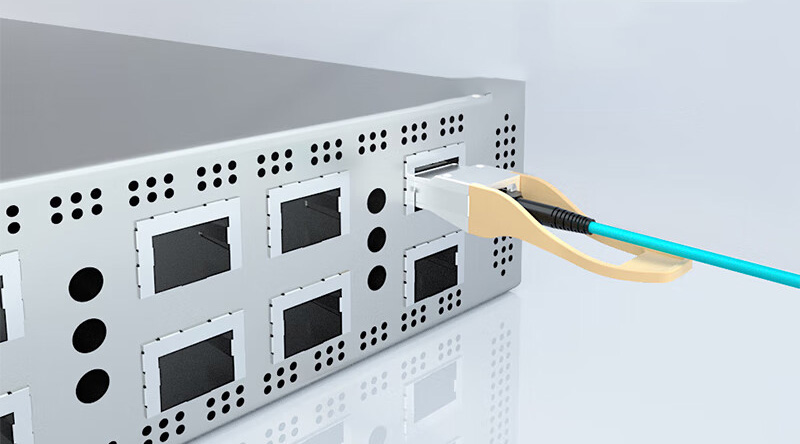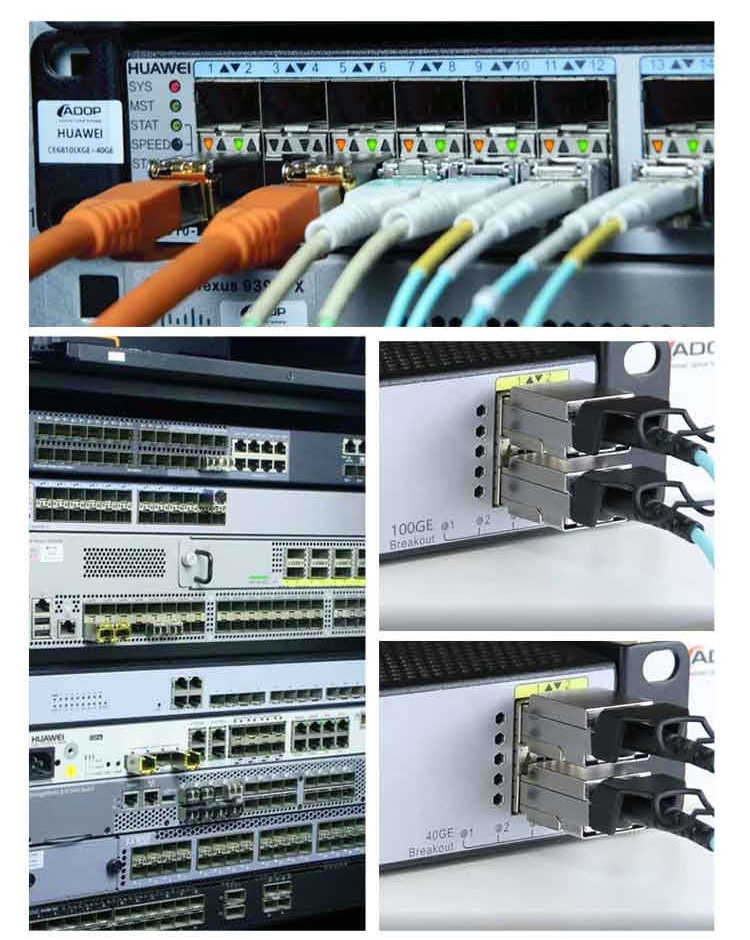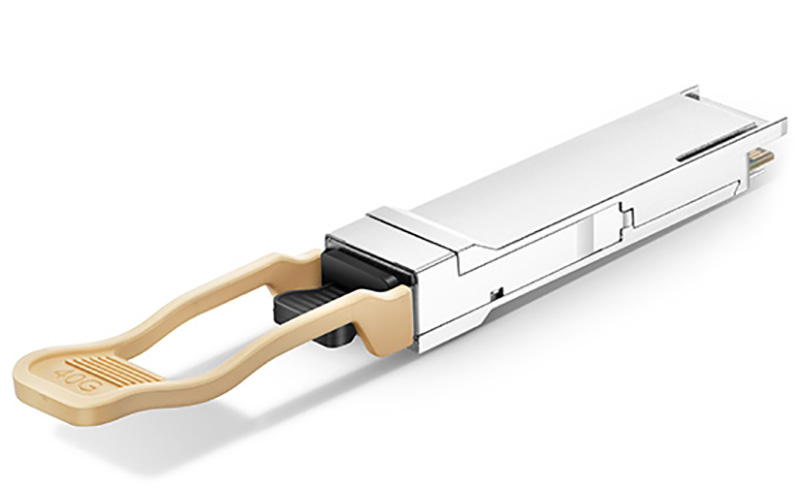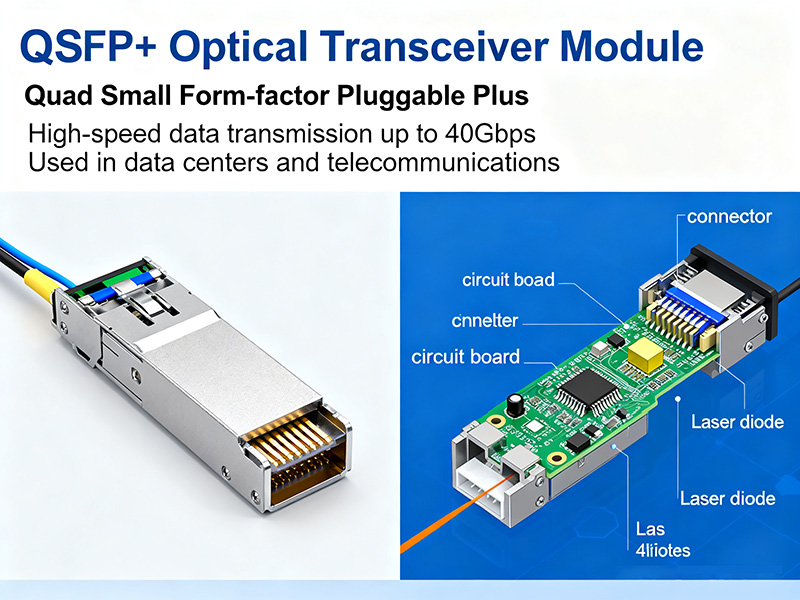What QSFP+ Modules Bring to 40G Network Architecture — From Principles to Deployment

With more data demand than ever before, data centers and organizations are embarking on developing efficient 40G networks capable of moving massive amounts of traffic with low latency and high reliability. In this context, traditional solutions seem incapable of balancing performance, density, and energy consumption, resulting in unintended performance bottlenecks and prohibitively high costs.
QSFP+ modules provide an alternative by allowing a compact, high-performance 40G link that is easier to integrate and provides a higher level of operational simplicity. The design can combine multiple 10G channels into a single 40G link, easily expanding efficient bandwidth.
This introduction highlighted performance data and practical case experiences to illustrate how QSFP+ modules effectively solve your most pressing network problems. Having knowledge of QSFP+ technologies and successful deployment practices equips infrastructure decision-makers to make their spending models more efficient and allows them to remain nimble as network demand increases.
What Is a QSFP+ Module? Definition and the 40G Transmission Principle
A QSFP+ (Quad Small Form-factor Pluggable Plus) module is a compact and hot-pluggable optical transceiver with a transmission capability of 40 gigabits per second. It can be thought of as four 10G channel capabilities joined into one package, which transmits data separately over four lanes at the same time, without combining them into a singular stream of data.
QSFP+ is quite different from SFP modules, where you typically get either 1G or 10G on a single lane. While SFP+ supports a single 10G channel, QSFP+ multiplies this channel capability by four. An advantage of parallelism is the increased bandwidth and increased port density that is needed to support heavy traffic in large-scale network environments.
Transmission principles can also differ with QSFP+. QSFP+ modules, such as the QSFP 40G SR4, use parallel optics, meaning that four separate 10G signals are running simultaneously over four distinct fibers, whereas technologies such as DWDM may combine signals on one fiber with distinct wavelengths. Utilizing QSFP+ parallel methods benefits both latency and layout, since you do not have to multiplex signals for transmission.
Short-reach multimode fiber with MPO/MTP connectors is also a favorable benefit for the layout.

How Does a QSFP+ Module Interface with Network Standards and Protocols?
QSFP+ modules use MPO/MTP optical connectors that bundle many fibers – typically eight – into one connector to convey four 10G channels simultaneously transmitting data in both directions. The combination of multimode fiber and the common multi-fiber connectors is used in short-distance, low-cost data center links, which simplifies installation and maintenance.
These modules comply with IEEE 802.3ba standards, specifically the 40GBASE-SR4 standard that specifies transmitting over short-range multimode fiber for 40 Gigabit Ethernet. This compliance provides predictable interoperability in multi-vendor scenarios, which is extremely important for enterprise and data center networking.
In addition to Ethernet, QSFP+ modules support protocols such as InfiniBand, commonly used to cluster high-performance computing systems. The variety of protocols supported by QSFP+ modules makes them flexible options for many applications that require reliable, low-latency, high-throughput connections.
Standardized interfaces minimize vendor lock-in and facilitate the transition to upgraded networks. Facility operators can expect consistent performance while broadening support across the ecosystem and aligning with industry-standard practices.
Why Is the QSFP+ Module Architecture Ideal for 40G Networks?
The QSFP+ architecture employs a compact and parallel 4-channel architecture to efficiently balance port density and heat dissipation. The QSFP+ module transmits four 10G lanes in parallel, using a small package to save switch real estate and to enable good thermal dissipation, a crucial feature in dense network environments.
QSFP+ modules are hot-swappable, meaning they may be replaced or upgraded without having to power down the network devices, leading to minimal downtime and enhanced network availability when performing maintenance or scaling.
QSFP+ is generally energy efficient, consuming optimized power, with energy use being below many alternatives per gigabit transmitted. You have few cables and fewer transceiver ports; therefore, the total cost of ownership is significantly lower. These benefits facilitate deployment and allow for scalable growth vertically and horizontally for 40G network topologies.

How to Choose the Right QSFP+ Module for Your 40G Network?
When selecting an appropriate QSFP+ module, one must consider a few important parameters: distance, fiber type, Digital Optical Monitoring (DOM) capability, and vendor support.
Distance is important as it determines whether short-reach multimode or long-reach single-mode modules are necessary. Many data centers employing multimode fiber as an intra-rack or short interconnection benefit from lower costs and easier cabling options than single-mode fiber. Enterprises with campus-style networks may require the long-reach capabilities of single-mode fiber in order to maintain high signal quality over distances.
Fiber type will also impact signal quality and cost. Multimode fiber is suitable for shorter distances, while single-mode can extend the distance expectations but with potential increased cost. Making sure that the original module matches the existing wiring and infrastructure will make the installation process smoother and the cost of an upgrade unnecessary.
The DOM capability allows continuous and real-time monitoring of various optical parameters including temperature, voltage, and optical power. These capabilities can help prepare and maintain the performance of the network by alerting to potential performance issues or component failures before becoming serious, which is even more important as network speeds continue to expand to 40G.
Vendor compatibility ensures that firmware, hardware, and vendors are in alignment, which is especially important in multi-vendor networks as it reduces eliminates interoperability issues. Purchasing modules from a reputable manufacturer that has reasonable testing and warranty policies will help mitigate risk and facilitate easier technical support in the event that it is necessary.
By aligning these parameters with the needs of the network, either data center network applications or enterprise applications, administrators can maintain performance, reliability, and costs while ensuring that a major investment is future-proofed.
How to Diagnose and Troubleshoot Common QSFP+ Module Issues?
Failures and performance issues in QSFP+ modules can occur due to signal loss, physical damage, or electrical issues. Things like contaminated connectors or bent fibers impact signal strength. In addition, overheating or failing hardware can result in communication issues; packet loss or failures in link stability can result from overheating or faulty components.
Digital Optical Monitoring (DOM diagnostics) is one way to provide operators with operational health parameters in real time. This kind of insight allows proactive diagnosis of failures, which results in operators being able to act early to troubleshoot an issue before the fault worsens, helping reduce downtime.
Structured troubleshooting would include:
- Examining connectors and cables for contamination or damage; cleaning or replacing cables or connectors as necessary.
- Examining the DOM metrics, specifically temperature, voltage, and optical power, for abnormalities indicative of hardware failures.
- Swapping out suspect modules to isolate known faulty hardware.
- Confirming compatibility with host equipment to ensure firmware or other incompatibilities are not the issue.
- Testing for fiber continuity and inline signal integrity using, as an example, optical power meters or an OTDR.
These steps will ensure troubleshooting can be as effective and expedient as possible, helping to maintain high uptime for important 40G links.

Where Does QSFP+ Shine? Exploring Typical Use Cases for 40G Modules
QSFP+ modules are ideal to deploy in environments that require high bandwidth with low latency, such as data centers, high-performance computing (HPC) clusters, and enterprise backbone networks. In a data center, QSFP+ will allow high throughput for east-west traffic flow between servers and storage, which is critically important as many services require processor overload (in virtualization or cloud services, for example) without speed or throughput degradation.
In an HPC infrastructure, QSFP+ modules enable low-latency data transit from one node to another during large-scale simulations and computations. When there are much larger data sets moving from one node to another, the high-speed 40G QSFP+ capability accelerates the communication required for real-time data processing and is a core requirement for HPC.
As you go to the enterprise, QSFP+ modules can be deployed on the data center or the enterprise backbone to connect multiple sites and support all the interoffice traffic—especially with higher loading requiring large volumes of data to transit between the offices. QSFP+ improves latency and scales well to do so without any additional connectivity or requirements.
A good example of this is with a financial services data center that was operating at 10G channels with 10G QSFP+ ports. After upgrading to 40G QSFP+ ports, that financial services data center realized a four-time increase in uplink throughput without increasing the existing rack footprint.
HPC environments have also experienced similar reductions in processing times through efficient usage of the 40G QSFP+ modules in support of their processing efficiency. Both examples show that QSFP+ modules improve agility and scale, which is imperative for all networks experiencing high demands for more data.
How a Major Data Center Successfully Deployed QSFP+ 40G Modules
A prominent global data center encountered challenges of increasingly high network traffic and finite port capacity. The legacy 10G links were not able to keep pace with the increased workloads, which resulted in throughput bottlenecks and application latency. The finite physical space further complicated where the facility could expand.
The adoption of QSFP 40G SR4 modules consolidated four 10G lanes into a single 40G connection, effectively quadrupling port density (without equating to a fourfold rack footprint). The parallel structure mitigated thermal issues and maintained network performance parameters under heavy operation.
A few key learnings operationally were to ensure early vendor verification for compatibility to avoid slow days of integration. The Digital Optical Monitoring (DOM) functionality allowed for identification of issues quickly and resulted in limited downtime.
Continuing staff training and updates of the firmware contributed to performance and reliability. This is a representative case of the impact of QSFP+ and how it can enable the transformation of 40G networks while mitigating costs and maintaining operational resiliency.
Comparing QSFP+ Modules by Brand and Capability
An assessment of comparative performance evaluated leading QSFP+ modules from three providers under controlled lab conditions. The transmitter distance, bit error rate (BER), and channel breakout performance were evaluated as part of the testing.
All modules achieved bit error-free performance over distances up to 100m over multimode fiber. With that said, there was a differentiation in performance under temperature stress testing, with some brands of modules sustaining lower BER or higher reliability and longevity, demonstrated by lower BER under the same conditions.
The channel breakout, or splitting a single 40G channel into four separate 10G channels, showed minor differences that may impact interoperability with other network hardware.
In conclusion, buyers should focus on module performance that provides a low BER, and look for modules with a stable channel breakout in developing a robust 40G link. In all cases, working with vendors that supported their module products with published test reports limited the risk to buyers and sustained additional network uptime during deployments.
What’s Next? Understanding the Future of QSFP+ and 40G Network Evolution
With a QSFP+ base, the area of 28G per lane is developed into QSFP28, allowing for a 100G network with backwards compatibility. QSFP-DD (Double Density) adds two lanes for a total of 8 lanes, allowing for 400G, while also fitting the incredible growth of data traffic for the future.
Being aware of these different form factors and technologies provides network architects the ability to think about migration paths that can be economically efficient and ultimately scalable. Investing ahead of time into emerging standards keeps the infrastructure from being totally redone.
Understanding what is coming beyond the QSFP+ form factor, then QSFP28, and finally QSFP-DD enables an organization to scale 40G networks naturally with the progression of their company and underlying technological advances.

Conclusion
QSFP+ modules form a crucial foundation of both current and future 40G networks, providing compact, high-speed connectivity essential to meeting increased demand for data. The development of QSFP+ modules balances scalability, efficiency, and heat dissipation capabilities to facilitate network growth with cost management.
Effectively selecting, deploying, and maintaining the network depends on our understanding and use of QSFP+ modules and the technology’s modular component capabilities while operating the network reliably and efficiently. Proper alignment of selected modules to the operational requirements and the vendors’ functional capacity provides maximum value to the operator while minimizing risks, ensuring maximum uptime.
A collection of sufficient data across a complete tech stack, with an informed strategy for action using QSFP+ technologies, enables strategic and confident operational infrastructure decisions while yielding sustainable and attractive 40G network-ready environments for the future.
Reference Sources
- IEEE 802.3ba-2010 – IEEE Standards Association
- Small Form-factor Pluggable – Wikipedia
- InfiniBand – Wikipedia
- 100 Gigabit Ethernet – Wikipedia
- Cisco 40GBASE QSFP Modules Data Sheet – Cisco Systems
- Multi-fiber Push On (MPO) Connectors – Fluke Networks
